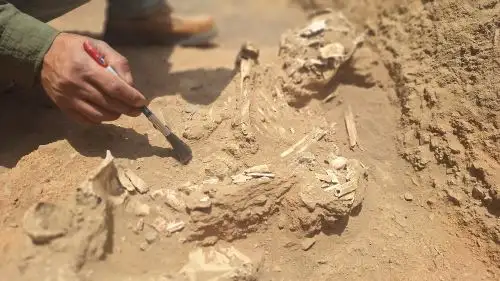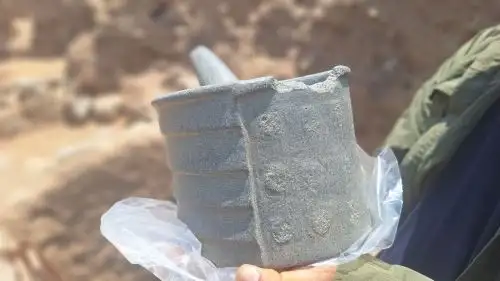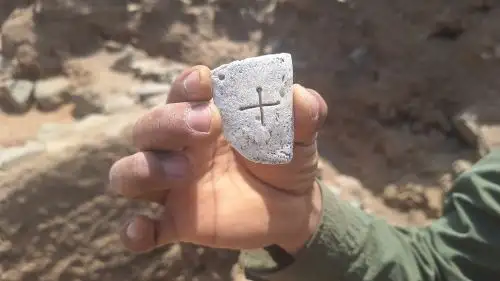09:00 | Trujillo (La Libertad region), Sep. 23.
Some 4,500 years ago, a great lord who dominated the interior of the Moche River valley lived in what is now known as the Monumental Archaeological Zone Castillo de Jesus Maria.
The site extends across approximately 22 hectares in the town of the same name, within the populated center of Menocucho, Laredo district, Trujillo province, La Libertad region, northern Peru.
Evidence of his existence and importance in his time was found by a group of Peruvian and U.S. researchers from the Menocucho Archaeological Research Project (PIAM, its Spanish acronym).
Since 2022, it has sought to understand the behavior and adaptations of the ancient inhabitants of Moche Valley's interior zone.

PIAM Director Aldo Watanave told Andina News Agency that it is a funerary platform located north of the Jesus Maria huaca (formerly Menocucho), where five individuals were buried during a single burial event, the most important of whom is the Lord of Jesus Maria.
Funerary context
The main individual was buried in a tomb measuring 3.5 meters long by 3.6 meters wide in a half-moon shape. He was in a seated position, facing east.
On his chest, two earrings made from malacological products (shells) were placed, featuring a cross at the center resembling the Southern Cross seen in the sky; on his left leg, a Choromytilus chorus shell valve rested, and at his side, a mortar with a grinding stone.
Outside this tomb, a "subadult" or young individual was found in an extended position, facing north.

The secondary tomb measures 1.65 meters long by 1.45 meters wide, and the individual was in a flexed position on his left side, also facing east.
On the side of the heart, a stone with oval points was placed. Based on the size of the remains, Watanave believes this individual was likely a woman.
Likewise, outside this tomb, the remains of an infant were found, but due to poor preservation, neither their position nor the direction they were facing can be determined.
Finally, outside both tombs, a third "subadult" individual was found with the body extended, also facing north.
"Preliminarily, we believe that each tomb had an accompanying individual, but further analysis of the findings is still required," he said.
The tombs were built with stone and mud mortar and were apparently plastered on the outside, while the interior was filled with very large stones. Two huge rocks can still be seen, serving as a form of protection for the main individual.
"As we have observed, we are facing a kind of funerary platform, which was used for the burial of a very important figure, an adult male. He was possibly a community leader before the site became known as Menocucho," said Watanave.

Preceramic period
The University of Florida researcher explained that, before this discovery, the only evidence of preceramic occupation in the Moche Valley had been recorded in Salaverry district.
"Radiocarbon dating is still pending to determine the age of the individuals, but the absence of ceramics in the funerary platform, and the association of the mortar with the grinding stone, indicates that this burial corresponds to the Preceramic period, about 4,500 years ago. This would be the first of its kind recorded in the interior of the Moche Valley," he added.
The mortar
Aldo Watanave explained that the mortar is made of stone and features two types of decorations.
On one side, carvings form four raised lines, while the other shows about 23 rectangular shapes, which may have represented small faces, although due to the poor state of preservation this cannot be confirmed.
"What these findings seem to be telling us is that there was a duality, between the ocean side, reflected in the malacological products found here, and the inland side, reflected in the stonework, showing a kind of convergence in the Moche Valley," he added.
PIAM
The Menocucho Archaeological Research Project has been carrying out excavations in the upper-middle part of the Moche Valley since 2022.
The team, led by Watanave, aims to understand how the populations of this area lived, which is why several excavation units have been conducted in recent years.
Findings to date include malacological elements, ceramic fragments, beads, and stone, quartz, and other mineral decorations associated with different cultures, demonstrating long-term occupation of the site.
An important aspect of the project is community outreach, aimed at raising awareness among the population about the care, protection, and preservation of the site.
For this reason, much of the team is made up of local residents, who assist in each stage of excavation and research.
The rest of the team includes PIAM's resident archaeologist Elvis Monzon, and principal researcher Michelle Watanave.
(END) LPZ/MAO/JMP/MVB
Published: 9/23/2025